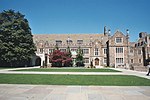Wallace Wade Stadium
1929 establishments in North CarolinaAmerican football venues in North CarolinaCollege football venuesDefunct athletics (track and field) venues in the United StatesDuke Blue Devils football ... and 4 more
Duke Blue Devils sports venuesRose Bowl GameSports venues completed in 1929Sports venues in Durham, North Carolina

Wallace Wade Stadium, in full Brooks Field at Wallace Wade Stadium, is a 40,004-seat outdoor stadium in the southeastern United States, located on the campus of Duke University in Durham, North Carolina. Primarily used for American football, it is the home field of the Duke Blue Devils of the Atlantic Coast Conference. Opened 95 years ago in 1929, it was the first facility in Duke's new West Campus. Originally Duke Stadium, it was renamed in 1967 for former head coach Wallace Wade. The playing surface was renamed Brooks Field at the beginning of the 2015 season after the removal of the track and lowering of the field-level seats.
Excerpt from the Wikipedia article Wallace Wade Stadium (License: CC BY-SA 3.0, Authors, Images).Wallace Wade Stadium
Whitford Drive, Durham
Geographical coordinates (GPS) Address Nearby Places Show on map
Geographical coordinates (GPS)
| Latitude | Longitude |
|---|---|
| N 35.995277777778 ° | E -78.941666666667 ° |
Address
Whitford Drive 120
27705 Durham
North Carolina, United States
Open on Google Maps









